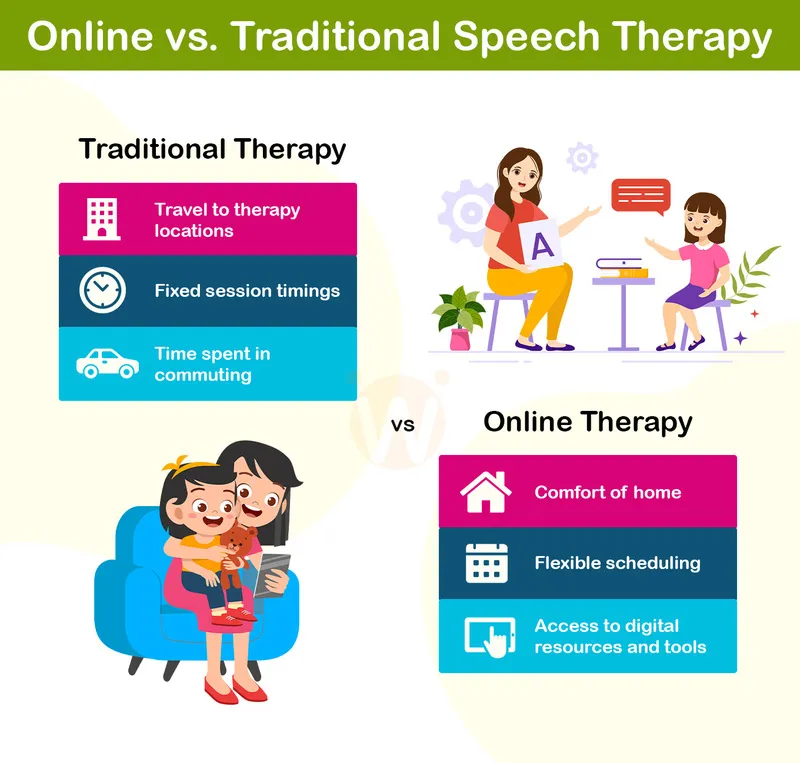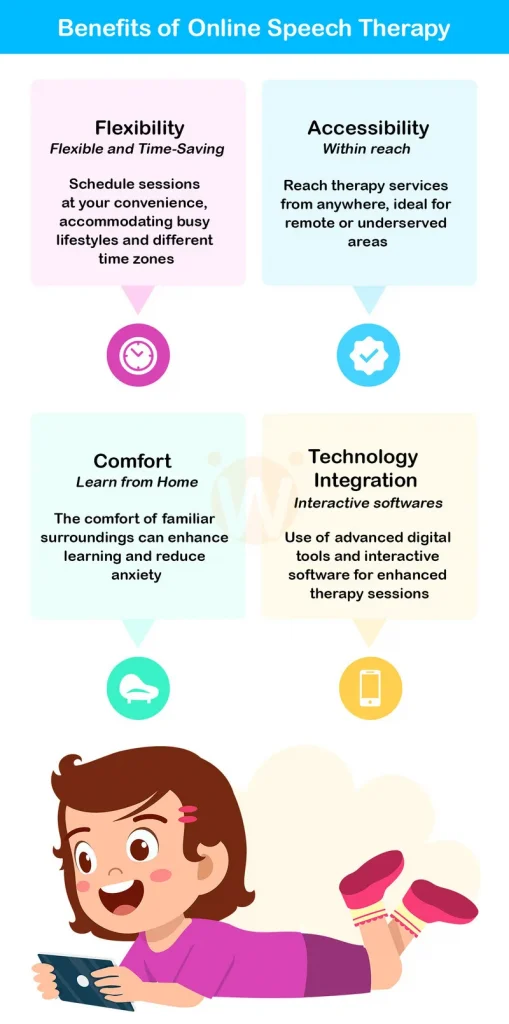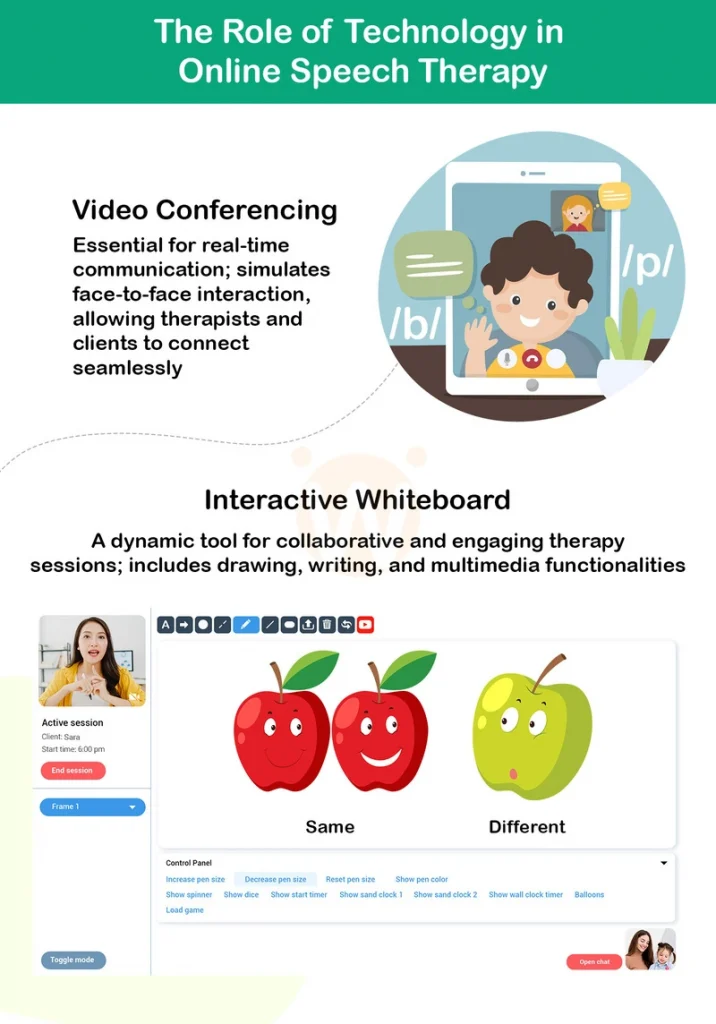Is Online Speech Therapy Effective? A Comprehensive Overview
By Rajini D
Last Updated: January 10, 2024
Have you ever wondered if therapy could be as effective over a screen as it is in person?
With the rise of online services in every corner of our lives, from grocery shopping to education, even speech therapy has gone virtual. Whether you’re a parent navigating your child’s communication challenges or a professional looking to expand your therapy options, the shift to online speech therapy can feel like a leap into the unknown. But is it really as effective as traditional, face-to-face sessions?
In this article, we’ll dive into how online speech therapy has revolutionized care, breaking down its benefits, challenges, and how it compares to in-person treatment. By the end, you’ll have a clear understanding of what makes online speech therapy an effective, accessible option for many. Let’s explore how technology is reshaping the way we support speech and language development from anywhere.
The Rise of Online Speech Therapy
Imagine being able to get the speech therapy your child needs without leaving home. The move from traditional, in-person sessions to online speech therapy has made this possible, and it’s changing the way many families get support. Thanks to technology, therapists can now work with children through video calls and fun, interactive tools, making therapy easier to access no matter where you live.
With tools like video chats and online games, therapists can provide the same level of care remotely. This means children in rural areas, or those with busy schedules, can still get the help they need. For many parents, this is a huge relief. No more long drives or juggling schedules—online therapy brings expert support straight to your home.
In fact, more and more speech therapists are offering online sessions, and the feedback has been very positive. Many therapists and parents report that children engage just as well, if not better, in the comfort of their home environment. For example, a parent who struggled to find time for therapy sessions can now simply log in from home, making it easier to fit into a busy day.
It’s important to remember that online therapy isn’t the same for everyone. The success of online sessions can depend on factors like the type of speech difficulty, the tools being used, and how comfortable the child is with technology. For instance, a child who struggles with verbal communication might benefit from visual aids, which can be used more easily in online sessions.
Understanding Online Speech Therapy
Online speech therapy, also called teletherapy or virtual speech therapy, is a way for therapists to provide speech and language support through video calls and online activities. Instead of meeting in person, therapists and clients connect over the internet, which makes it easier for people who live far away, have trouble traveling, or need more flexible schedules.
For example, a child who lives in a remote area with no nearby speech therapists can still get help through online sessions. Similarly, a busy parent can fit therapy into their day without worrying about travel.
There are two main types of online speech therapy:
- Synchronous sessions: These are live, one-on-one sessions where the therapist and child interact over a video call. It’s just like a regular therapy session but happens online. The therapist can give immediate feedback and adjust the session as needed. For instance, if a child is struggling with a particular sound, the therapist can help correct it in real-time.
- Asynchronous sessions: In this type of session, the therapist sends activities and exercises that the child can complete on their own time. It’s a great way for kids to practice and reinforce what they’ve learned between live sessions. For example, a therapist might send some speech exercises to work on during the week.
Online therapy usually starts with a video call assessment to understand the child’s needs. From there, the therapist creates a personalized plan with fun and engaging activities, like speech games or flashcards, to help improve their communication skills.
Many kids enjoy online therapy because it uses interactive tools like games, which keep them engaged. A child might even feel more comfortable practicing speech at home rather than in a clinic, making the experience more enjoyable and effective.
Overall, online speech therapy offers a flexible and convenient way for children to get the help they need, whether through live sessions or independent practice, all from the comfort of home.
Effectiveness of Online Speech Therapy

Recent studies have shown that online speech therapy can be just as effective as traditional, in-person therapy. In fact, many children who receive teletherapy make similar progress in improving their speech and language skills compared to those attending face-to-face sessions. For example, a study conducted in 2020 found that children participating in online speech therapy saw significant improvements in their ability to articulate words and in their language development—just like their peers in in-person therapy.
Online therapy also brings its own set of advantages. No more long drives to the therapist’s office or the hassle of scheduling appointments around a busy day. Instead, therapy can happen right at home, making it more convenient for both parents and children. This ease often leads to more consistent and frequent therapy sessions, which is key for children’s progress.
Take, for instance, a parent who struggles to find time for regular in-person appointments due to work commitments. With online therapy, they can schedule sessions during lunch breaks or after school, making it easier to stay on track. Plus, the comfortable home environment can help children feel more at ease, leading to better engagement during the session.
Comparison of Online and In-Person Speech Therapy
| Criteria | Online Therapy | In-Person Therapy |
|---|---|---|
| Accessibility | High accessibility: therapy sessions can be accessed from anywhere with an internet connection. Ideal for individuals in remote or rural areas. | Limited by geographical location. Requires traveling to a therapist’s office, potentially challenging for those in remote areas. |
| Cost | Generally more cost-effective due to reduced overhead costs and travel expenses. | Often more expensive due to costs associated with physical space, travel expenses, and potentially higher session rates. |
| Flexibility | High flexibility in scheduling; sessions can be arranged to fit around the client’s lifestyle and availability. | Scheduling can be less flexible, dependent on the therapist’s office hours and availability. |
| Engagement Tools | Utilizes digital tools and interactive software, like Wellness Hub’s Synchronized Whiteboard, for enhanced engagement. | Relies on physical materials and direct interaction; may lack the technological enhancements available in online settings. |
| Effectiveness | Studies show similar outcomes to in-person therapy, with effectiveness enhanced by digital tools and tailored software. | Proven effectiveness through direct, personal interaction and traditional methods, but may lack the innovative digital tools of online therapy. |
Also Read: In-Person vs. Online Speech Therapy: Which is More Effective?
Data supports these findings as well. In one survey, over 75% of speech-language pathologists reported that teletherapy is an effective way to deliver speech therapy services. Many parents also express high satisfaction with online therapy, praising its flexibility and accessibility.
Advantages of Online Speech Therapy

Online speech therapy has gained popularity due to its many benefits, particularly in terms of accessibility and convenience. For families living in rural or remote areas where in-person speech therapy services may be limited, online therapy provides a critical solution. Using digital tools, children and adults can now access quality speech therapy services from anywhere, eliminating the need for long drives or waiting for nearby services to become available.
For example, imagine a child living in a small town with no local speech therapists. Through online therapy, they can receive the help they need without their family having to travel hours for each session.
Another major advantage is flexibility. Traditional therapy often requires appointments during office hours, which can be challenging for busy parents or therapists with packed schedules. Online therapy allows for more flexible scheduling, making it easier to arrange sessions at times that work for both parties. This flexibility often leads to more consistent attendance, which is key to making progress in speech development.
Take, for instance, a parent who works full-time. With online speech therapy, they can book sessions after work or even on weekends, making it much easier to maintain regular therapy without disrupting their daily routine.
Cost-effectiveness is another big plus. Since there’s no need to travel or take time off work or school, online therapy can save families both time and money. It reduces transportation costs and the need to rearrange schedules, making speech therapy more accessible to families who may otherwise struggle with the financial and logistical burden of in-person sessions.
Finally, receiving therapy in the comfort of home can be a huge advantage, especially for children. Kids are often more relaxed and open in their own environment, which can lead to better engagement and faster progress. A child who feels at ease in their familiar surroundings may be more willing to participate actively, making the therapy session more productive.
Challenges and Solutions
While online speech therapy has many benefits, it can also come with challenges. Here are some common issues and how Wellness Hub helps solve them:
- Technology Problems:
- Challenge: Poor internet connection or not having the right device can make sessions difficult.
- Solution: Wellness Hub offers easy-to-use platforms and provides support to help clients fix any technical issues quickly.
- Keeping Kids Engaged:
- Challenge: It’s harder to keep younger children focused during online sessions compared to in-person therapy.
- Solution: We use Tele-Basics, a tool that includes fun, interactive games and activities, along with real-time feedback, to make sessions more engaging and enjoyable for kids.
By solving these problems, Wellness Hub ensures that children can receive effective and seamless online speech therapy, no matter where they are.
Role of Technology in Online Speech Therapy

The success of online speech therapy depends a lot on the technology used during sessions. From video calls that allow therapists and clients to interact face-to-face to special software that supports different speech therapy activities, technology plays a key role. Tools like interactive apps for practicing sounds, language games, and voice exercises make therapy more engaging and effective.
At Wellness Hub, we understand how important it is to use the right technology. Our platform uses advanced software to ensure clear video communication, so therapists and clients can interact smoothly. We also use tools like speech recognition software to help track and improve speech clarity. These features are designed to fit the needs of each client, making therapy more personalized and effective.
For example, if a child is working on improving their speech sounds, they might use an interactive app that provides instant feedback on their progress. Or, for a child practicing language skills, a fun language development game can keep them engaged while reinforcing key skills.
Read about the innovative online speech therapy redefined with Tele-Basics.
Involvement of Therapists and Caregivers
The success of online speech therapy relies heavily on the skill and dedication of the Speech Language Therapist. These professionals are responsible for providing effective therapy and customizing each session to fit the client’s needs. In an online setting, therapists use digital tools to keep children engaged, track their progress, and make adjustments to their therapy plans as needed.
But therapists aren’t the only ones involved—caregivers, especially parents, play a crucial role as well. Their support is essential, particularly for children or individuals who need extra help. At Wellness Hub, we make sure that caregivers are part of the process. Our platform allows parents and caregivers to stay involved in therapy by providing them with updates and tools to reinforce therapy goals at home.
For example, after an online session, a therapist might share activities that a parent can do with their child to practice what was learned. This collaboration between therapists and caregivers helps ensure steady progress and makes therapy even more effective.
Future of Online Speech Therapy
The future of online speech therapy is exciting, thanks to new technology that makes therapy more effective and engaging. At Wellness Hub, we’re leading the way with our Synchronized Whiteboard, a tool that’s changing how online therapy works.
The Synchronized Whiteboard has many useful features, like video and audio for live sessions, text conferencing, and tools for planning sessions. It also has built-in flashcards and access to apps like Autism Basics, which include fun games and activities to help kids learn in a more interactive way.
Conclusion
The future of online speech therapy is bright, thanks to innovative tools like Wellness Hub’s Synchronized Whiteboard. This tool brings therapy to life with features like interactive video, audio, flashcards, and real-time collaboration. These advancements make therapy more engaging, fun, and effective for children, allowing them to work on their goals in a personalized and convenient way. As technology continues to evolve, online speech therapy will become an even more powerful option for families.
Frequently Asked Questions:
1. What is online speech therapy?
Online speech therapy is a mode of delivering speech and language therapy services through digital platforms. It involves the use of video conferencing, interactive tools, and digital resources to provide therapy remotely.
2. How does online speech therapy compare to traditional in-person therapy?
Online therapy offers similar effectiveness to in-person therapy, with added benefits like flexibility, convenience, and access to innovative digital tools like Wellness Hub’s Synchronized Whiteboard. Research indicates that outcomes in online therapy can be comparable to traditional settings.
3. Can online speech therapy be effective for children?
Yes, online speech therapy can be highly effective for children. It utilizes interactive tools and games, like those available through Wellness Hub’s platform, which are particularly engaging for young learners.
4. Is online speech therapy suitable for all types of speech disorders?
Most speech and language disorders can be effectively treated online. However, the suitability depends on individual cases and specific needs. Consultation with a qualified therapist can help determine if online therapy is the right approach.
5. What technology is needed for online speech therapy?
Basic requirements include a stable internet connection, a computer or tablet with a camera and microphone, and access to a speech therapy platform like Wellness Hub.
6. How does Wellness Hub enhance online speech therapy?
Wellness Hub enhances online speech therapy through its Synchronized Whiteboard, which offers interactive tools, integrated educational apps, and engaging therapy games, making sessions more effective and enjoyable.
7. Can caregivers participate in online speech therapy sessions?
Yes, caregiver involvement is encouraged in online speech therapy, especially for children and individuals requiring additional support. Wellness Hub’s platform facilitates this involvement by providing resources and tools for caregivers.
8. What are the benefits of online speech therapy for clients in remote or rural areas?
Online therapy provides access to quality speech therapy services regardless of location, eliminating the need for long commutes and offering therapy in the comfort of one’s home.
9. How are therapy sessions planned and conducted online?
Sessions are planned based on individual needs. Therapists use digital tools like video conferencing, interactive whiteboards, and customized activities, as seen with Wellness Hub’s innovative platform.
10. What future advancements can be expected in online speech therapy?
Future advancements include the integration of more advanced AI and machine learning tools, enhanced interactive software, and more personalized therapy approaches, all of which Wellness Hub continues to explore and integrate.
About the Author:
Rajini Darugupally
M.Sc., Speech-Language Pathologist (9+ years of experience)
Rajini is a passionate and dedicated Speech-Language Pathologist with over 9+ years of experience, specializing in both developmental speech and language disorders in children and rehabilitation in adults. Driven by a desire to empower each individual to find their voice, Rajini brings a wealth of experience and a warm, genuine approach to therapy. Currently, at Wellness Hub, she thrives in a team environment that values innovation, compassion, and achieving results for their clients.
Book your Free Consultation Today
Parent/Caregiver Info:
Client’s Details:
* Error Message








